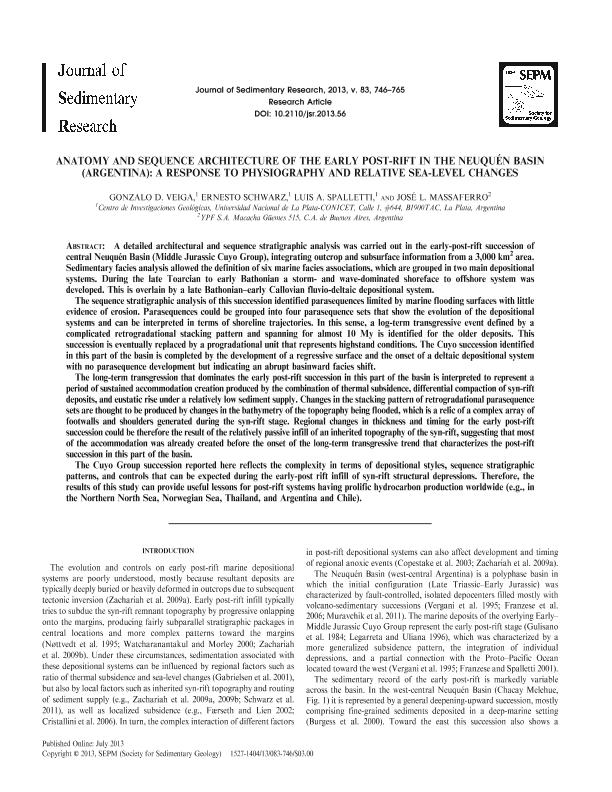Artículo
Anatomy and Sequence Architecture of the early Post-Rift in the Neuquén Basin (Argentina): A Response to Physiography and Relative Sea-level Changes
Fecha de publicación:
08/2013
Editorial:
Society for Sedimentary Geology
Revista:
Journal Of Sedimentary Research
ISSN:
1073-130X
Idioma:
Inglés
Tipo de recurso:
Artículo publicado
Clasificación temática:
Resumen
A detailed architectural and sequence stratigraphic analysis was carried out in the early-post-rift succession of central Neuque´n Basin (Middle Jurassic Cuyo Group), integrating outcrop and subsurface information from a 3,000 km2 area. Sedimentary facies analysis allowed the definition of six marine facies associations, which are grouped in two main depositional systems. During the late Toarcian to early Bathonian a storm- and wave-dominated shoreface to offshore system was developed. This is overlain by a late Bathonian–early Callovian fluvio-deltaic depositional system. The sequence stratigraphic analysis of this succession identified parasequences limited by marine flooding surfaces with little evidence of erosion. Parasequences could be grouped into four parasequence sets that show the evolution of the depositional systems and can be interpreted in terms of shoreline trajectories. In this sense, a log-term transgressive event defined by a complicated retrogradational stacking pattern and spanning for almost 10 My is identified for the older deposits. This succession is eventually replaced by a progradational unit that represents highstand conditions. The Cuyo succession identified in this part of the basin is completed by the development of a regressive surface and the onset of a deltaic depositional system with no parasequence development but indicating an abrupt basinward facies shift. The long-term transgression that dominates the early post-rift succession in this part of the basin is interpreted to represent a period of sustained accommodation creation produced by the combination of thermal subsidence, differential compaction of syn-rift deposits, and eustatic rise under a relatively low sediment supply. Changes in the stacking pattern of retrogradational parasequence sets are thought to be produced by changes in the bathymetry of the topography being flooded, which is a relic of a complex array of footwalls and shoulders generated during the syn-rift stage. Regional changes in thickness and timing for the early post-rift succession could be therefore the result of the relatively passive infill of an inherited topography of the syn-rift, suggesting that most of the accommodation was already created before the onset of the long-term transgressive trend that characterizes the post-rift succession in this part of the basin. The Cuyo Group succession reported here reflects the complexity in terms of depositional styles, sequence stratigraphic patterns, and controls that can be expected during the early-post rift infill of syn-rift structural depressions. Therefore, the results of this study can provide useful lessons for post-rift systems having prolific hydrocarbon production worldwide (e.g., in the Northern North Sea, Norwegian Sea, Thailand, and Argentina and Chile).
Archivos asociados
Licencia
Identificadores
Colecciones
Articulos(CIG)
Articulos de CENTRO DE INVEST.GEOLOGICAS (I)
Articulos de CENTRO DE INVEST.GEOLOGICAS (I)
Citación
Veiga, Gonzalo Diego; Schwarz, Ernesto; Spalletti, Luis Antonio; Massaferro, Jose L; Anatomy and Sequence Architecture of the early Post-Rift in the Neuquén Basin (Argentina): A Response to Physiography and Relative Sea-level Changes; Society for Sedimentary Geology; Journal Of Sedimentary Research; 83; 8; 8-2013; 746-765
Compartir
Altmétricas




